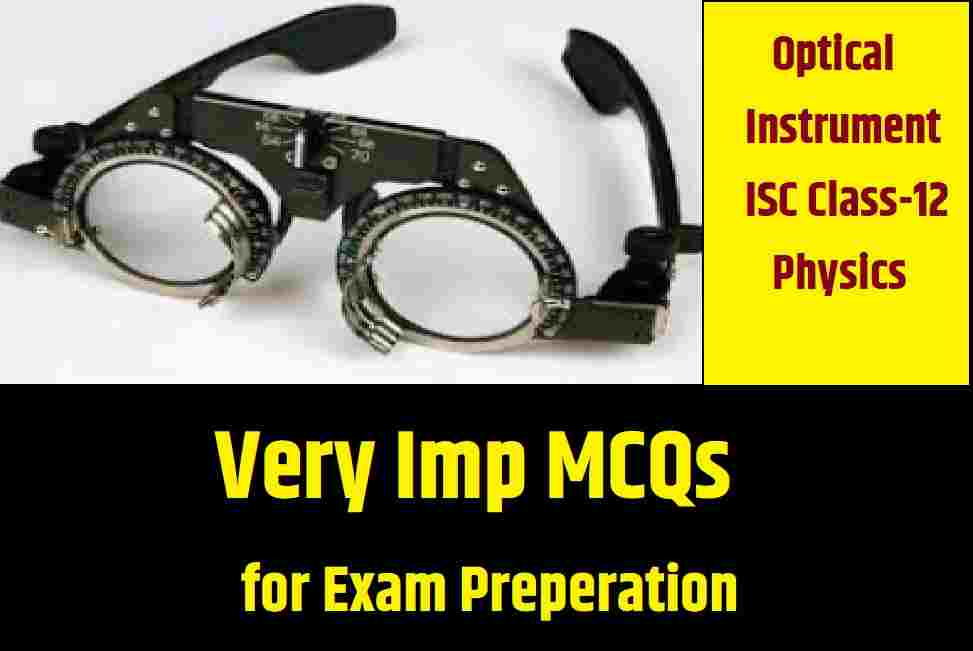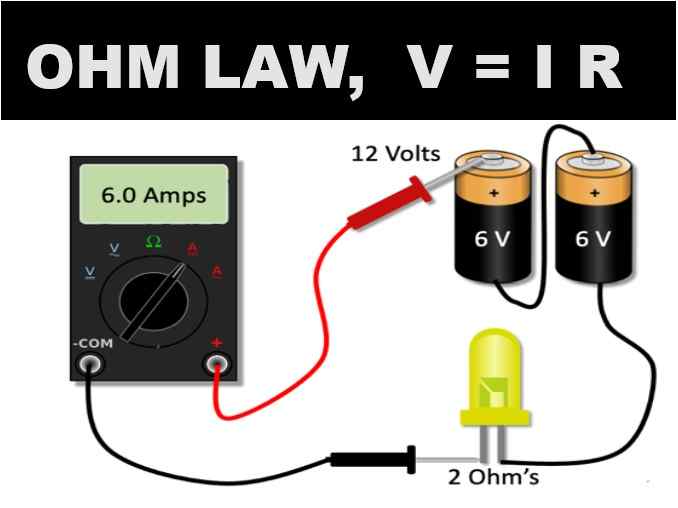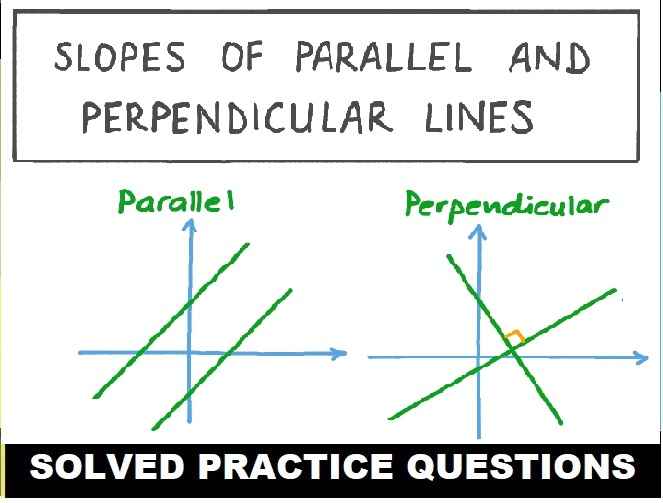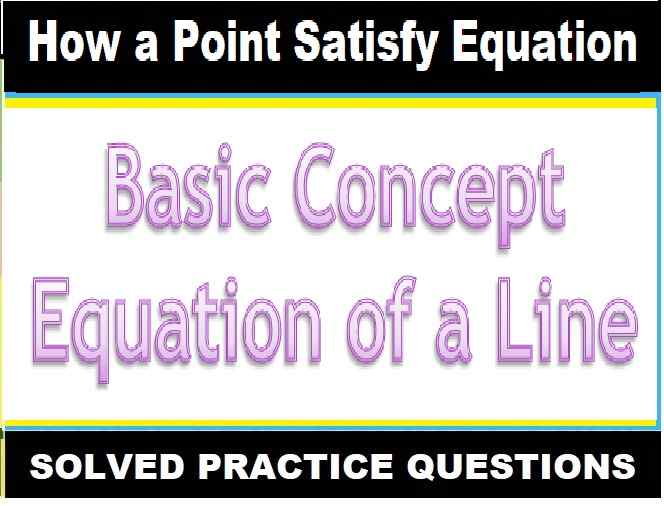Optical Instrument MCQs Type Questions with Answer for ISC Class 12 . These MCQs / Objective Type Questions is based on latest reduced syllabus according 2021-22 session on bifurcated pattern. Main motto of MCQ Type Question is cracking the next upcoming Sem-2 exam of council. Visit official website CISCE for detail information about ISC Class-12 Physics.
ISC Class 12 Optical Instrument MCQs Type Questions with Answer

| Board | ISC |
| Class | 12th (XII) |
| Subject | Physics |
| Chapter | Optical Instrument |
| Syllabus | on bifurcated syllabus (after reduction) |
| Session | 2021-22 |
| Bifurcated | Sem-2 |
| Topic | MCQs / Objective Type Question |
MCQs Optical Instrument ISC Class 12 Physics
Question 1: The mirror formula is given by
(a) 1/f = 1/v – 1/u
(b) 1/v = 1/f -1/u
(c) 1/f = 1/v + 1/u
(d) None
Answer: (c) 1/f = 1/v + 1/u
Question 2: When the angle of incidence of a light ray is greater than the critical angle it gets
(a) critically refracted
(b) totally reflected
(c) total internally reflected
(d) totally refracted
Answer: (c) total internally reflected
Question 3: A man’s near point is 0.5 m and far point is 3 m. Power of spectacle lenses required for (i) reading purposes, (ii) seeing distant objects, respectively, are
(a) –2 D and + 3 D
(b) +2 D and –3 D
(c) +2 D and –0.33 D
(d) –2 D and + 0.33 D
Answer: (c) +2 D and –0.33 D
Question 4: The light reflected by a plane mirror may form a real image
(a) if the rays incident on the mirror are diverging
(b) if the rays incident on the mirror are converging
(c) if the object is placed very close to the mirror
(d) under no circumstances
Answer: (b) if the rays incident on the mirror are converging
Question 5: In image formation from spherical mirrors, only paraxial rays are considered because they
(a) are easy to handle geometrically
(b) contain most of the intensity of the incident light
(c) form nearly a point image of a point source
(d) show minimum dispersion effect
Answer: (c) form nearly a point image of a point source
Question 6: The distances measured in the direction opposite to the direction of incident light are taken as
(a) Positive
(b) Negative
(c) Both a and b
(d) None
Answer: (b) negative
Question 7: The heights measured upward with respect to X axis and normal to the principal axis of mirror or lens are taken as
(a) Positive
(b) Negative
(c) Both a and b
(d) None
Answer: (a) positive
Question 8: Total internal reflection can take place only if
(a) light goes from optically rarer medium (smaller refractive index) to optically denser medium
(b) light goes from optically denser medium to rarer medium
(c) the refractive indices of the two media are close to different
(d) the refractive indices of the two media are widely different
Answer: (b) light goes from optically denser medium to rarer medium
Question 9: The geometric centre of the spherical mirror is called as
(a) Pole of the mirror
(b) Optical centre
(c) Centre of curvature
(d) None
Answer: (a) pole of the mirror
Question 10: Critical angle of light passing from glass to water is minimum for
(a) red colour
(b) green colour
(c) yellow colour
(d) violet colour
Answer: (d) violet colour
Question 11: In spherical mirror, the line joining pole and the centre of curvature is called as
(a) Optical axis
(b) Principal axis
(c) Major axis
(d) None
Answer: (b) principal axis
Question 12: The distances measured in the same direction as the incident light are taken as
(a) Negative
(b) Positive
(c) Both a and b
(d) None
Answer: (b) positive
Question 13: A planoconvex lens of focal length 16 cm, is to be made of glass of refractive index 1.5. The radius of curvature of the curved surface should be
(a) 8 cm
(b) 12 cm
(c) 16 cm
(d) 24 cm
Answer: (a) 8 cm
Question 14: The turning back of light into the same medium after incident on a boundary separating two media is called
(d) interference of light
Answer: (a) reflection of light
Question 15: In case of concave mirror, the reflected rays converge at a point on the principal axis which is called as
(a) Focus
(b) Principal focus
(c) Optical centre
(d) Pole
Answer: (b) principal focus
Question 16: The electromagnetic radiation belonging to the region of spectrum 400nm – 700nm is called as
(a) Microwave
(b) Infrared
(c) Light
(d) Gamma rays
Answer: (c) light
Question 17: Rainbow is formed due to the combination of
(a) refraction and absorption
(b) dispersion and focusing
(c) dispersion and total internal reflection
(d) refraction and scattering
Answer: (c) dispersion and total internal reflection
Question 18: Refractive index of material of a prism is √2. The angle of prism is 60o. What is the angle of minimum deviation?
(a) 30o
(b) 45o
(c) 60o
(d) 90o
Answer: (a) 30o
Question 19: The bundle of rays of light constitute to form the
(a) Bundle of light
(b) Packets of light
(c) Both a and b
(d) Beam of light
Answer: (d) beam of light
Question 20: The geometric centre of spherical lens is called as
(a) Pole of the mirror
(b) Optical centre
(c) Centre of curvature
(d) None
Answer: (b) optical centre
Question 21: A glass slab of thickness 4 cm contains the same number of waves as 5 cm of water when both are traversed by the same monochromatic light. If the refractive index of water is 4/3, what is that of glass?
(a) 5/3
(b) 5/4
(c) 16/15
(d) 1.5
Answer: (a) 5/3
Question 22: An object is placed at a distance of 40 cm from a concave mirror of focal length 15 cm. If the object is displaced through a distance of 20 cm towards the mirror, the displacement of the image will be
(a) 30 cm away from the mirror
(b) 36 cm away from the mirror
(c) 30 cm towards the mirror
(d) 36 cm towards the mirror
Answer: (c) 30 cm towards the mirror
Question 23: In case of spherical lenses, the line joining optical centre with its principal focus is called as
(a) Optical axis
(b) Principal axis
(c) Principal radius
(d) Radius of curvature
Answer: (b) principal axis
Question 24: A point object is placed at the centre of a glass sphere of radius 6 cm and refractive index 1.5. The distance of the virtual image from the surface of the sphere is
(a) 2 cm
(b) 4 cm
(c) 6 cm
(d) 12 cm
Answer: (c) 6 cm
Question 25: Mirage is a phenomenon due to
(a) refraction of light
(b) reflection of light
(c) total internal reflection of light
(d) diffraction of light.
Answer: (c) total internal reflection of light
Question 26: For reflection through spherical surfaces, the normal at the point of incidence is
(a) perpendicular to the principle axis and passes through the centre of curvature
(b) perpendicular to the focal plane and passes through the pole.
(c) perpendicular to the tangent plane at pole and passes through the focus.
(d) perpendicular to the tangent plane at the point of incidence and passes through the centre of curvature.
Answer: (d) perpendicular to the tangent plane at the point of incidence and passes through the centre of curvature.
Question 27: In case of convex mirror, the reflected rays appear to diverge from the point on the principal axis which is called as
(a) Pole of the mirror
(b) Optical centre
(c) Principal focus
(d) None
Answer: (c) principal focus
Question 28: An object is placed 40 cm from a concave mirror of focal length 20 cm. The image formed is
(a) real, inverted and same in size
(b) real, inverted and smaller
(c) virtual, erect and larger
(d) virtual, erect and smaller
Answer: (a) real, inverted and same in size
Question 29: A short pulse of white light is incident from air to a glass slab at normal incidence. After travelling through the slab, the first colour to emerge is
(a) blue
(b) green
(c) violet
(d) red
Answer: (d) red
Question 30: The magnifying power of an astronomical telescope in normal adjustment is 100. The distance between the objective and the eyepiece is 101 cm. The focal length of the objectives and eyepiece is
(a) 10 cm and 1 cm respectively
(b) 100 cm and 1 cm respectively
(c) 1 cm and 100 cm respectively
(d) 1 cm and 10 cm respectively
Answer: (b) 100 cm and 1 cm respectively
Question 31: If the rays originating from the point, actually meet at another point after reflection or refraction then that point is called as
(a) Object of first point
(b) Image of first point
(c) Both a and b
(d) None
Answer: (b) image of first point
Question 32: Which of the following is incorrect statement?
(a) the magnification produced by a convex mirror is always less than one
(b) a virtual, erect, same-sized image can be obtained using a plane mirror
(c) a virtual, erect, magnifield image can be formed using a concave mirror
(d) a real, inverted, same-sized image can be formed using a convex mirror.
Answer: (d) a real, inverted, same-sized image can be formed using a convex mirror.
Question 33: The heights measured downward with respect to X axis and normal to the principal axis of mirror or lens are taken as
(a) Positive
(b) Negative
(c) Both a and b
(d) None
Answer: (b) negative
Question 34: Electromagnetic radiation belonging to _________ region of spectrum is called light.
(a) 100 nm to 400 nm
(b) 400 nm to 750 nm
(c) 750 nm to 10 nm
(d) 1000 nm to 1400 nm
Answer: (b) 400 nm to 750 nm
Question 35: The distance between the principal focus F and pole of the mirror P is called as
(a) Optical radius
(b) Principal radius
(c) Focal length
(d) None
Answer: (c) focal length
Question 36: A person is six feet tall. How tall must a plane mirror be if he is able to see his entire length?
(a) 3 ft
(b) 4.5 ft
(c) 7.5 ft
(d) 6 ft
Answer: (a) 3 ft
Question 37: If f is the focal length of the mirror then R = 2f, R is called as
(a) Principal radius
(b) Radius of curvature
(c) Both a and b
(d) None
Answer: (b) radius of curvature
Question 38: If the critical angle for total internal reflection from a medium to vacuum is 30o, the velocity of light in the medium is
(a) 3 X 108 m/s
(b) 1.5 X 108 m/s
(c) 0.5 X 108 m/s
(d) 0.2 X 108 m/s
Answer: (b) 1.5 X 108 m/s
Question 39: A convex lens of focal length f = 20 cm is combined with a diverging lens of power 65 D. The power and the focal length of the combination is
(a) ‒1.5 D, 66.7 cm
(b) 1.5 D, 33.7 cm
(c) 5 D, 66.7 cm
(d) 5 D, 33.6 cm
Answer: (c) 5 D, 66.7 cm
Question 40: The power of a thin convex lens of glass is 5 D. When it is immersed in a liquid, then it behaves like a divergent lens of focal length 100 cm. The refractive index of the liquid is:
(Given, refractive index of glass = μ = 1.5)
(a) 3/5
(b) 1/2
(c) 2/3
(d) 5/3
Answer: (d) 5/3
Question 41: An equiconvex lens of focal length f and power P is cut into two halves in thickness. The focal length and power of each half is
(a) f/2
(b) 2f
(c) f
(d) zero
Answer: (b) 2f
Question 42: The sky would appear red instead of blue if
(a) atmospheric particles scatter blue light more than red light
(b) atmospheric particles scatter all colours equally
(c) atmospheric particles scatter red light more than blue light
(d) the sun was much hotter
Answer: (c) atmospheric particles scatter red light more than blue light
Question 43: A certain far-sighted person cannot see objects closer to the eye than 100 cm. The power of the lens which will enable him to read at a distance of 25 cm will be?
(a) 3D
(b) 1D
(c) 4D
(d) 2D
Answer: (a) 3D
Question 44: The reddish appearance of rising and setting sun is due to
(a) reflection of light
(b) diffraction of light
(c) scattering of light
(d) interference of light
Answer: (c) scattering of light
Question 45: The radius of curvature of the curved surface of a plano-convex lens is 20 cm. If the refractive index of the material of the lens be 1.5, it will
(a) act as a convex lens only for the objects that lie on its curved side.
(b) act as a concave lens for the objects that lie on its curved side.
(c) act as a convex lens irrespective of the side on which the object lies.
(d) act as a concave lens irrespective of side on which the object lies.
Answer: (c) act as a convex lens irrespective of the side on which the object lies.
Question 46: Four lenses of focal length ±15 cm and ±150 cm are available for making a telescope. To produce the largest magnification, the focal length of the eyepiece should be
(a) +15 cm
(b) +150 cm
(c) –150 cm
(d) –15 cm
Answer: (a) +15 cm
Question 47: The velocity of light in vacuum is 3 × 1010 cms-1. The velocity of light in a medium (µ = 1.5) is:
(a) 2 × 1010cms-1
(b) 4.5 × 1010cms-1
(c) 1.5 × 1010cms-1
(d) None of these
Answer: (a) 2 × 1010cms-1
Question 48: Which of the following is not essential for the formation of a pure spectrum?
(a) parallel beam of light
(b) narrow beam of light
(c) screen
(d) prism in the minimum deviation position
Answer: (c) screen
Question 49: Critical angle of glass is θ2 and that of water is θ2. The critical angle for water and glass surface would be (μg = 3/2, μw = 4/3).
(a) less than θ2
(b) between θ1 and θ2
(c) greater than θ2
(d) less than θ1
Answer: (c) greater than θ2
Question 50: The ray of light incident at any angle at the pole then reflected ray
(a) Doesn’t follows laws of reflection
(b) Follow laws of reflection
(c) Both a and b
(d) None
Answer: (b) follows laws of reflection
–: End of Photoelectric Effect MCQs :–
-: also visit :-
- ISC Sem-2 Question Bank Class-12
- Sem-2 ISC Specimen Paper for Class-12
- ISC Class-12 Textbook Solutions ,Syllabus, Solved Paper
- Previous Year Question Paper for ISC Class-12
Please share with your ISC friends if it is helpful
Thanks


